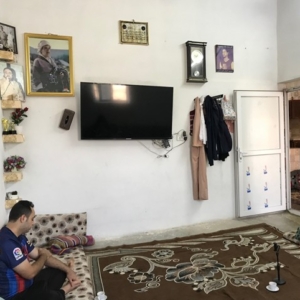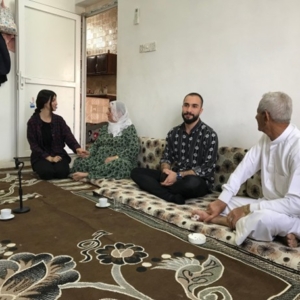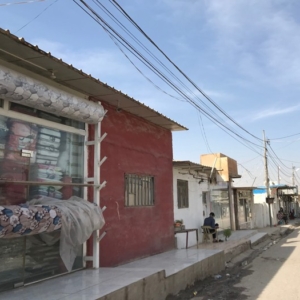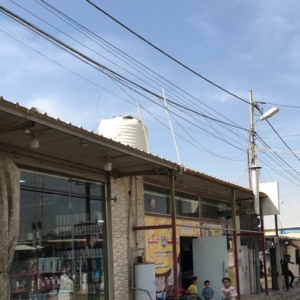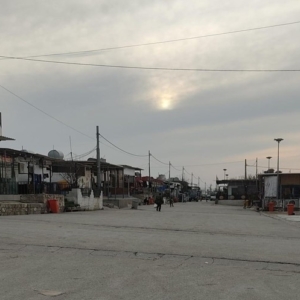Deq (Arabic: دەق) or xal (Kurdish: خاڵ) are the Arabic and Kurdish words for tattoo respectively. Traditional Deq (tattoo) or Xal has long been a part of cultural heritage in Kurdistan and Iraq, it is shared by multiple ethnic and religious groups in Kurdistan, such as Yazidis, Shabaks, the Assyrians and many others. It has been practiced by both men and women, even though it has been far more common among women.
Growing up, many of us heard stories from our family members about how they received their Deqs. Some of them recalled doing it themselves on their hands and face, some reflected back at their life in the village and how an unknown tattooist visited them offering to apply Deq in exchange for small payments, food, or utensils that are no longer needed. Getting a Deq was not just a personal choice, it was a trend of their time. Those who would get it would encourage others to do the same, and soon, it spread throughout their communities.
Loss of cultural practices
However, in our immediate surroundings, this cultural practice has nearly disappeared. It has vanished almost completely from our region, and younger generations no longer perceive it as a part of their cultural heritage. In 2023, During a class discussion at the university in our course on our heritage in the Department of Sociology, we found ourselves wondering about the disappearance of this traditional practice.
We had so many questions that made us go beyond theories and look for real life stories of those who still carried this tradition on their skin. We became increasingly curious about why Deq is no longer practiced? What made people embrace it in the past? What social and cultural meanings did it hold? And it was through this curiosity, that led us to the people of Rojava (western kurdistan), refugees in Domiz Camp, 20 km away from Duhok city center, where we hoped to understand the significance of Deq from those who still bore its marks.
Zainab’s story
Zainab Mousa Tahir, born in Qamishli, in her 60s, recalls enduring years of abject poverty. At the time she married, she embroidered scarves, tablecloths, and other items, working tirelessly alongside her husband in a shared struggle to assure the barest necessities for their children. Her husband, Gouri Abdulrazaq, is her cousin, who was twenty years old, when she was ten when they got married, and soon after, they left Qamishli and moved to the village to live with her husband’s family. For the most part, they lived in Tell-Khanzir، for nearly thirty years, they worked in the cotton fields. Together, they raised 13 children.
Zainab’s connection to traditional Deq (tattoos) began in her early childhood. When she was just five or six, her mother engraved a Deq above her lip and chin, believing she would be protected by the evil eye. As she grew older, she chose to make them herself on her skin, engraving three dots of tattoo (Deqs) onto her right hand, three on her legs, and one on her chest all by her own hands, because she found them as a symbol of beauty, and as a source of pride, especially with her white skin.
After many years, when she learned that deq was considered forbidden in Islam, she regretted it, but removing them was not an option. Deq was permanent, and trying to erase them meant burning the skin. Therefore, she said “I never removed them, I left them just as they are.” She had 6 daughters, and she also applied Deq on them, again as a protective measure as her mom did, to protect them from evil eyes.
The tradition of Deq
Zainab said, in her time, the ink for Deq was traditionally made by mixing soot with breast milk of a woman who had given birth to a baby girl. There was a belief that such milk made the ink last longer and appear darker than that of a mother who had given birth to a son. Their belief in this played a deep role in their lives. Traditional Deq differs from modern tattooing because it was applied by pricking or striking the skin with a needle and rubbing ink into the wounds, rather than simply imprinting ink onto the skin. This engraving method is why the term “Deq” is used. Zainab’s husband, Gouri, had a deq on the top of his nose, engraved there by his mother. She had lost many children in infancy, and when Gouri was born, she named him “Gouri,” which means sacrifice, to protect him from an early death. Strangely enough, he and his younger brother were the only ones among his siblings to survive.
In the past, there was another belief among women, they believed that getting a Deq on their right hand would prevent their husbands from marrying another wife. But not all women followed this belief, such as Zainab. Laughing, she said, “That was for women with handsome husbands, not for me.”
Preserving generational memories
There exist many other stories like Zainab’s story. Yet, as time passes, the voices that carry these memories grow fewer, and with them, an entire cultural practice risks being lost. In our Sociology of Heritage course, we learned about the complexities of heritage and its significance in forming our identity as individuals. It also taught us the role of memory in shaping heritage, including nostalgia, collective memory, and forgetting. That is why, documenting Deq is not just about tattoos, it is about preserving the lived experiences of generations before us and keeping their memories alive.
The Sociology of Heritage course was introduced to the Department of Sociology by the University of Duhok as part of the collaboration with the Middle East Culture Conservation Collective initiative. The Course is taught for second year sociology students by Professor Zubeida Abdulkhaliq.

